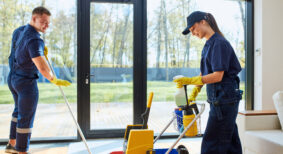The cleaning industry has been around for a while, but new technologies like augmented reality (AR) and virtual reality (VR) are new to the field. Some tech specialists believe that by 2020, most companies will be forced to use enhanced versions of reality in training programs in order to stay competitive and attract younger employees as the aging workforce retires.
“As digital natives, this younger generation is acutely aware of their future and where they want to invest their time and energy,” says Alan Smithson, CEO of MetaVRse, a leading VR and AR consulting and product development company. “Having a VR training program not only assures them a company is cutting edge, but also allows them to learn in ways that increase efficiency across a spectrum of learning.”
AR overlays computer graphics on top of someone’s view of the real world, while VR completely immerses users in that world. These technologies are quickly impacting the automotive sector, but exist at more conceptual levels within the cleaning industry.
Some members, however, are undergoing a digital transformation to keep up-to-date with the modern user experience. Diversey, a cleaning and hygiene company, expects more exposure seeping into the daily lives of average consumers as Google and Apple invest heavily in reality technologies.
“We need to make sure that we, as an industry, align to the personal user experience,” says Marc Robitzkat, global director of marketing technology at Diversey. “In the old days, individual consumers were seeing laptops and computers at work. Today, it’s almost the reverse effect; users exposed to state-of-the-art technology at home on their personal devices are not exposed to smart technologies at work.”
Remote guidance and immersive solutions
Supporting technical service is one way AR technology can address issues within the cleaning and maintenance industry. As Smithson points out, enabling maintenance workers with AR headsets gives them step-by-step instructions in a novel way, instead of looking at a manual, website or phone.
Another “very, very new” solution currently being tested at companies like Airbnb is the concept of geotagging a flag and leaving sticky notes in AR space. These notes, which facility managers could use to tackle various problems in need of repair, would float around in mid-air for staff to discover at the beginning of a work day.
These solutions can also manage significant turnover the industry contends with, upskilling employees anywhere and anytime, without the need for onsite training. Employees learn to self-troubleshoot and guide themselves through a process, which can help reduce errors and address knowledge transfer.
“Training and re-training can be a costly affair,” says Robitzkat. “Using AR could guide employees through real-time simulation on a piece of equipment or process without their having prior knowledge of that task. Re-training can be self-guided through smart technology.”
Diversey has been experimenting with AR technology for a while with its Intellibot Robotics floor cleaning machines, which don’t have to be in a room in order to train people. Instead, users can walk around and experience 360 degree interaction with a life-size projection and learn about its components.
This can also be used operationally onsite. In a troubleshooting scenario, replacing parts, for example, AR technology would project onto the actual device, pinpointing where to unhinge a screw, change a pack or pull a wire. During a night shift, an untrained employee would have to make a quick decision, rather than depend on an integrated video that is more time consuming.
“In maintenance, you want this technology to increase and speed up the process,” adds Smithson. “What is being developed right now is testing assumptions that AR will make us faster, and it’s showing a 20 to 25 per cent decrease in training time and increase in retention rates.”
Less training time could raise health and safety concerns, but proponents of AR tech feel it adds more benefits than human errors.
“Like with any operational process, health and safety standards must be ensured and followed with or without technology,” notes Robitzkat. “Using tools like AR as an enabler can only emphasize that right steps are taken and the knowledge to do it right is at hand.”
In VR training, Smithson adds, it’s either hands on a machine or a 2D screen training simulator. People learning from their computers or phones are not really paying attention or fully engaged.
“When using AR and especially VR, you’re completely immersed in that training, and managers have an incredible amount of data because headsets are tracking where you are looking at any given time,” he says. “With complex and expensive machinery, you can train people in advance without their ever touching it, reducing injuries and danger.”
Increased safety and efficiency is just one aspect that may propel reality technologies into the mainstream professional arena with wider adoption across the industry on a global level.
“It’s really about seeing these technologies that are emerging as enabling technologies,” says Robitzkat. If we want to be in touch with today’s technology trends and make sure we can be sustainable with the business in the future, these are things we can’t ignore. There are many opportunities to deploy smart technologies in our industry.”








